
The San Remo conference was an international meeting of the post-World War I Allied Supreme Council as an outgrowth of the Paris Peace Conference, held at Castle Devachan in Sanremo, Italy, from 19 to 26 April 1920. The San Remo Resolution passed on 25 April 1920 determined the allocation of Class "A" League of Nations mandates for the administration of three then-undefined Ottoman territories in the Middle East: "Palestine", "Syria" and "Mesopotamia". The boundaries of the three territories were "to be determined [at a later date] by the Principal Allied Powers", leaving the status of outlying areas such as Zor and Transjordan unclear.

The Emirate of Transjordan, officially known as the Amirate of Trans-Jordan, was a British protectorate established on 11 April 1921, which remained as such until achieving formal independence in 1946.

The Peel Commission, formally known as the Palestine Royal Commission, was a British Royal Commission of Inquiry, headed by Lord Peel, appointed in 1936 to investigate the causes of unrest in Mandatory Palestine, which was administered by the United Kingdom, following a six-month-long Arab general strike.

The Palestine pound was the currency of the British Mandate of Palestine from 1 November 1927 to 14 May 1948, and of the State of Israel between 15 May 1948 and 23 June 1952, when it was replaced with the Israeli lira.
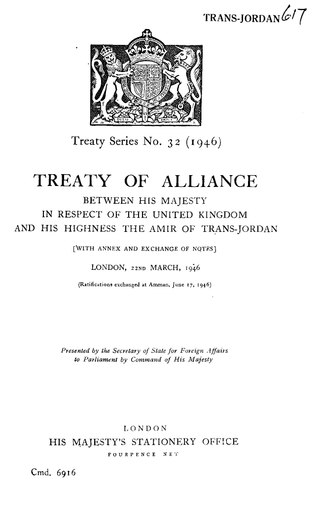
The Treaty of London was signed between the United Kingdom and the Emirate of Trans-Jordan on 22 March 1946 and came into force on 17 June 1946.
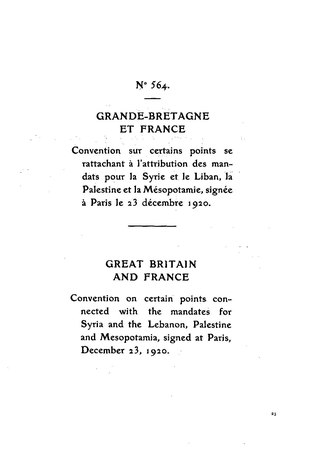
The Paulet–Newcombe Agreement or Paulet-Newcombe Line, was a 1923 agreement between the British and French governments regarding the position and nature of the boundary between the Mandates of Palestine and Iraq, attributed to Great Britain, and the Mandate of Syria and Lebanon, attributed to France. The 1923 line defined the border of Mandatory Palestine from the Mediterranean up to Al-Hamma, Tiberias. The 1920 line defined, in less detail, the border of the French Mandate for Syria and Lebanon from the Mediterranean up to Jeziret-ibn-Omar.
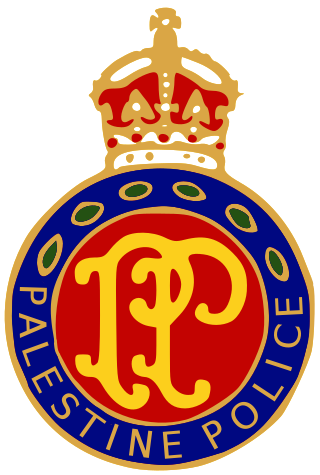
The Palestine Police Force was a British colonial police service established in Mandatory Palestine on 1 July 1920, when High Commissioner Sir Herbert Samuel's civil administration took over responsibility for security from General Allenby's Occupied Enemy Territory Administration (South). The police force was composed of Jewish, Arab and British officers. However, over the course of the Mandate, the police force became less representative of Palestinian populations and increasingly functioned to repress Palestinian political mobilization and to facilitate the establishment of a homeland for the Jewish people.

The 1921 Cairo Conference, described in the official minutes as Middle East Conference held in Cairo and Jerusalem, March 12 to 30, 1921, was a series of meetings by British officials for examining and discussing Middle Eastern problems, and to frame a common policy. The secret conference of British experts created the blueprint for British control in both Iraq and Transjordan. By offering nominal leadership of those two regions to the sons of the Sharif of the Mecca, Churchill felt that the spirit if not the actual letter of Britain's wartime promises to the Arabs were fulfilled.
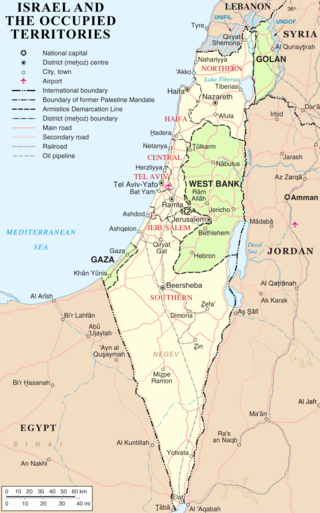
The modern borders of Israel exist as the result both of past wars and of diplomatic agreements between the State of Israel and its neighbours, as well as an effect of the agreements among colonial powers ruling in the region before Israel's creation. Only two of Israel's five total potential land borders are internationally recognized and uncontested, while the other three remain disputed; the majority of its border disputes are rooted in territorial changes that came about as a result of the 1967 Arab–Israeli War, which saw Israel occupy large swathes of territory from its rivals. Israel's two formally recognized and confirmed borders exist with Egypt and Jordan since the 1979 Egypt–Israel peace treaty and the 1994 Israel–Jordan peace treaty, while its borders with Syria, Lebanon and the Palestinian territories remain internationally defined as contested.

The Trans-Jordan Frontier Force was formed on 1 April 1926, to replace the disbanded British Gendarmerie. It was a creation of the British High Commissioner for Palestine whose intention was that the Force should defend Trans-Jordan's northern and southern borders. The TJFF was also an Imperial Service regiment whose Imperial Service soldiers agreed to serve wherever required and not just within the borders of their own colony, protectorate or, in the case of the Transjordan, mandate. This was in contrast to the Arab Legion, which was seen more as an internal security militia, deriving from the troops of the Arab Revolt and closely associated with the Hashemite cause. The Amir Abdullah was an Honorary Colonel of the Trans-Jordan Frontier Force from its inception. However, the local commanders thought it unnecessary to form an additional force, believing that the expansion of The Arab Legion would be a better action.

The Transjordan memorandum was a British memorandum passed by the Council of the League of Nations on 16 September 1922, as an addendum to the Mandate for Palestine.
This is a timeline of major events in the history of the modern state of Jordan.
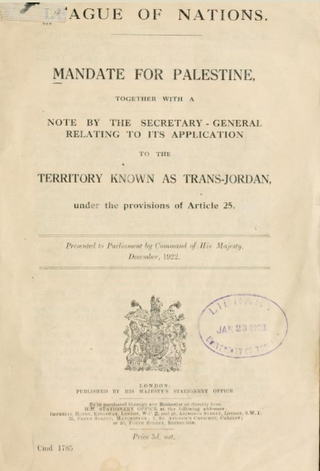
The Mandate for Palestine was a League of Nations mandate for British administration of the territories of Palestine and Transjordan, both of which had been conceded by the Ottoman Empire following the end of World War I in 1918. The mandate was assigned to Britain by the San Remo conference in April 1920, after France's concession in the 1918 Clemenceau–Lloyd George Agreement of the previously agreed "international administration" of Palestine under the Sykes–Picot Agreement. Transjordan was added to the mandate after the Arab Kingdom in Damascus was toppled by the French in the Franco-Syrian War. Civil administration began in Palestine and Transjordan in July 1920 and April 1921, respectively, and the mandate was in force from 29 September 1923 to 15 May 1948 and to 25 May 1946 respectively.

Mandatory Palestine was a geopolitical entity that existed between 1920 and 1948 in the region of Palestine under the terms of the League of Nations Mandate for Palestine.

The All-Palestine Government was established on 22 September 1948, during the 1948 Arab–Israeli War, to govern the Egyptian-controlled territory in Gaza, which Egypt had on the same day declared as the All-Palestine Protectorate. It was confirmed by the Arab League and recognised by six of the then seven Arab League members, with Transjordan being the exception. Though it claimed jurisdiction over the whole of the former Mandatory Palestine, its effective jurisdiction was limited to the All-Palestine Protectorate, which came to be called the Gaza Strip. The President of the protectorate was Hajj Amin al-Husseini, former chairman of the Arab Higher Committee, and the Prime Minister was Ahmed Hilmi Pasha. The legislative body was the All-Palestine National Council.

The Palestinian Citizenship Order 1925 was a law of Mandatory Palestine that created a Palestinian citizenship for residents of the territory of Palestine Mandate. It was promulgated on 24 July 1925 and came into force on 1 August 1925. The Order remained in effect until 14 May 1948, when the British withdrew from the Mandate, and Palestinian citizenship came to an end. Israel enacted a Citizenship Law in 1952, while West Bank residents came under Jordan’s nationality law.

The Occupation of Ma'an was the post-World War I occupation of the Sanjak of Ma'an, which straddled the regions of Syria and Arabia, by members of the Hashemite family, who came to power in various regions of the Near East and Arabia; they were King Hussein in the Kingdom of Hejaz, Emir Faisal representing the Arab government in Damascus and Abdullah, who was to become Emir of Transjordan. The region includes the governorates of Ma'an and Aqaba, today in Jordan, as well as the area which was to become a large part of the Israeli Southern District, including the city of Eilat.
The Interregnum period in Transjordan was a short period during which Transjordan had no established ruler or occupying power that lasted from the end of the Franco-Syrian War on 25 July 1920 until the Establishment of the Emirate of Transjordan in April 1921.
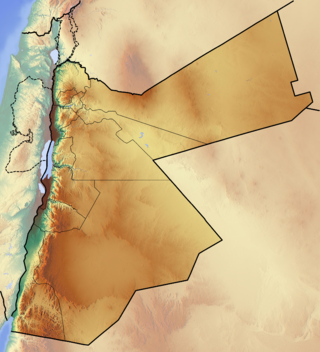
The Jordan–Saudi Arabia border is 731 km (454 mi) in length and runs from the Gulf of Aqaba in the south-west to the tripoint with Iraq in the north-east.
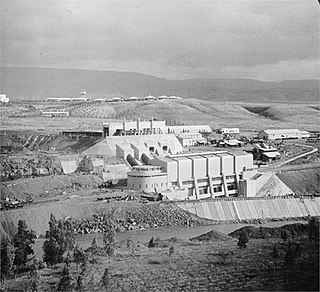
The First Jordan Hydro-Electric Power House, also known as the Rutenberg Power Station or the Naharayim Power Plant or the Tel Or Power Plant, was a conventional dammed hydroelectric power station on the Jordan river, which operated between 1932 and 1948. It was situated in the Emirate of Transjordan, but built to supply power to Mandatory Palestine. The plant was built in an area known as Jisr el-Majami, later renamed by the Palestine Electric Corporation as Naharayim, and following the Israel–Jordan peace treaty it is today part of the Jordanian area of Baqoura.

































